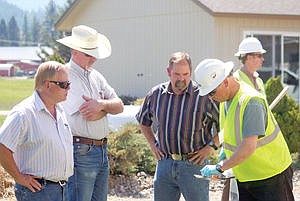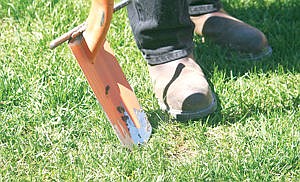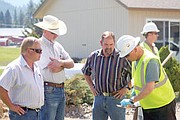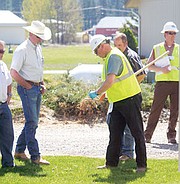Commissioners tour EPA inspection site
Bob Henline The Western News | Hagadone News Network | UPDATED 10 years, 7 months AGO
Lincoln County commissioners Mike Cole and Greg Larson joined the Environmental Protection Agency’s on-site project manager for Libby, Mike Cirian, on a property inspection site Tuesday afternoon.
The commissioners, along with Lincoln County Asbestos Resource Program manager Nick Raines and contractor CDM Smith site manager Tommy Cook, met with site inspectors and learned how the agency conducts the inspections and what triggers further inspections and/or property clean-ups.
“What it showed me is that the inspections are very thorough and conducted professionally,” Larson said. “They provide very useful information for property owners with a minimal amount of intrusion.”
The tour started at the EPA Information Center in Libby, where Cirian explained the process, as well as explained some basic safety precautions used
both by site personnel and visitors. He also said inspectors only look at properties where the owners have given permission. The agency cannot and will not enter a property without the owner’s written permission.
Once permission is given, a team will conduct a survey of the property, essentially staking off the property lines in order to ensure they don’t cross onto someone else’s property.
“It’s by no means a legal survey you can take down to the courthouse,” Cirian said. “But it gives us a map from which we can inspect the property without going onto somebody else’s land.”
The properties are divided into areas based upon the amount of anticipated use. Gardens and children’s play areas are considered higher-use areas, with remote acreage, “the lower 40” as Cirian labeled it, considered lower use.
Each area is given a 30-point composite sample, meaning samples are taken from 30 different points of each area.
The samples are each visually inspected for the presence of vermiculite, which appears to the naked eye as a shiny substance amidst the soil. Vermiculite, while a visual indicator that triggers a more detailed inspection, is not necessarily an indicator of the presence of asbestos.
If no vermiculite is visible, the sample is placed into a plastic bag with other samples of the same area. The bagged sample is processed in Troy and then shipped to an EPA facility in Golden, Colo. for laboratory analysis.
If vermiculite is visible in the sample, the inspector separates that sample from the rest of the area and then walks off five feet in each direction from the source of the vermiculite to sample again. The process continues until no vermiculite is visible. The sample containing the visible vermiculite is processed separately from the samples from the rest of the property.
If the laboratory investigation revels the presence of asbestos, a more detailed investigation is ordered.
CDM Smith’s Max Luick, who performed the soil investigation on the site being visited, explained the detailed analysis.
“We section the property into 3,000 square feet sections and take 30 aliquots from each section,” he said. An aliquot is a small sample used for laboratory analysis.
Luick used a small shovel-type instrument to take the samples from the site. The instrument had a blade approximately four inches wide, with which he dug about three inches deep into the soil to pull the aliquot. He then inspected the sample for visible indicators, of which there were none, and bagged the sample for processing.
After each sample was removed, Luick carefully tamped the soil back down and replaced the grass pulled aside by the shovel.
“Our goal is for the property owner to not even know we were here after we’re gone,” he said. “We want to be as unobtrusive as possible.”
In addition to the outside, inspectors also go inside to look for visible and open sources of possible contamination. They check attics and open ceiling areas for vermiculite insulation. They check openings in walls and floors as well as basements and any other open area. Samples taken are processed in the same manner as the soil samples taken from around the yard.
Cirian said a number of property owners consent to the inspection, but also tell inspectors they’re sure no contamination exists.
“When I had my own place inspected I kept telling the guys, ‘there’s nothing up there,’ but they’d go up and look anyway,” he said. “They have to, they have to document that they visually inspected every possible source of contamination.”
Documentation is stressed by Cirian and project personnel. Every visitor to the site was required to sign the logbook. Every conversation with property owners and even passers-by who inquire about the inspection is noted in the inspection log.
Larson said the documentation not only protects the property owners and the site personnel, but also provides peace of mind.
“I would find it comforting to know the status of my property with regard to asbestos contamination, and to have that status documented,” he said.
Cirian said there are approximately 1,500 properties within the National Priority List, or Superfund site, boundaries remaining to be inspected.
Cirian said owners have declined inspections for a number of reasons.
“Some just don’t trust the agency and don’t want us on their property,” he said. “Others may have family or personal events taking place and don’t want to be bothered right now. Others were waiting for the release of the toxicity values and the risk assessment. I think some more are still waiting for the release of the final remedy later this year.”
Earlier this year the agency sent approximately 450 postcards to property owners who had previously declined property inspections. Of that number, 45 contacted the agency and gave permission for the inspections.
Larson hopes everyone participates in the inspections.
“I would encourage people to have a sense of community and get this done while the resources are here,” he said.
Once the agency completes the active phase of the site clean-up, which is estimated to wrap up in the next three to five years, inspections and removal of contaminated material may end up being the responsibility of the property owner. The exact nature of the post-remedy management of the site, the institutional controls, is unknown at this point.
One potential issue facing local officials is the balancing act between public health and personal property rights. What happens if a property owner refuses inspection, but the property represents a source of potential contamination for neighbors and passers-by?
“I believe people should do what is right for the betterment of the community,” Larson said. “But I also understand and support personal property rights. I don’t know exactly how we should handle something like that. It’s a really tough call.”
Cirian said inspections will continue as long as the active clean-up is underway in Libby and he has the personnel and the resources to inspect every property within the site boundaries this year, if property owners agree to the inspections.
ARTICLES BY BOB HENLINE THE WESTERN NEWS
Hecla to acquire Mines Management
Hecla Mining Company and Mines Management Inc. announced a merger agreement May 24, 2016. The agreement is pending Mines Management shareholder approval and other undisclosed closing conditions.
Libby man arrested with knife on school bus
A 57-year-old Libby man was arrested Friday following an incident in which he allegedly boarded a school bus brandishing a knife because he felt the driver was going too fast.

Cole takes chairman's gavel
Breaking with years of tradition, the Lincoln County commissioners elected Eureka commissioner Mike Cole as chairman in their first meeting of the year on Wednesday.







